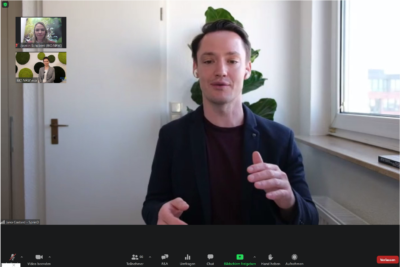
Microalgae for Greater Sustainability
How can algae be used to enable a more sustainable economy? The BIO.NRW.eco team addressed this issue in the “Algae – Biotechnological Applications” webinar on 2 December 2021. Over 130 people from 20 countries worldwide watched the online presentations on how microalgae can be used as an alternative biomass to create new added value.
Christoph Peiner, head of Fabric Production at RWTH Aachen University’s institute for textile technology (ITA), summed up the advantages of microalgae: They use CO2 as a source of carbon, have high growth rates, and can be produced all year long. Microalgae therefore have a number of advantages compared with land plants and are considered to be an additional sustainable source of raw materials for the implementation of a bio-based economy. Moreover, many functional chemicals and substances can be extracted from the algae biomass, making it a good alternative to fossil raw materials. The value creation potential for industry is high, since microalgae can be used in many different industrial sectors, for example for the production of food and feed, cosmetics and fine chemicals, as well as bioplastics.
It is therefore important to accelerate the industrial application of algae. The economic implementation of algae production on an industrial scale plays a key role here. Processes must be developed that allow for the high growth rates of algae to be scaled up. In addition, the photobioreactors used for algae cultivation require a lot of energy. The Cologne-based company Algenion focuses on process development. During the webinar, Algenion CEO Björn Podola presented an innovative concept for biofilm cultivation. Compared to suspension culture approaches, Algenion’s biofilm reactor saves additional resources in algae cultivation so that less water and energy are required. Biofilm reactors can be used in a wide range of applications – for example to produce nutrients or pigments, and to treat waste water.
Not only the cultivation of microalgae is crucial in industrial production, but also the downstream processes represent an important step in value creation. This was pointed out by Greta Canelli (a postdoc in ETH Zurich’s Sustainable Food Processing group) in her presentation, which put the spotlight on algae as a nutrient source. Greta explained that although microalgae are a source of polyunsaturated fatty acids (omega-3 fatty acids), the bioavailability in commercially available algae food products is low. Her work aims to increase the bioavailability of lipids and proteins. To this end, Greta uses a combination of enzymatic and innovative physical processing steps in downstream processing.
This product contains Algae!
The webinar also showed the wide range of applications that are based on the biotechnological use of algae. In the future, for example, microalgae will not only be used for food, but also for clothing. Christoph Peiner from ITA is working towards this goal. He is developing textile fibres from microalgae as part of the AlgaeTex project. In his presentation, he described how algae-based monomers can be used for the synthesis of polyamides and polyesters. Developing algae-based fabrics involves many steps. New synthesis pathways need to be established as well as the spinning and texturing of the algae-based polymers. The application demonstration is provided by the adidas brand.
Sofie Allert, CEO of Swedish Algae Factory, presented a completely new application. She and her team use algae to produce high-tech materials. From diatoms, they obtain a nanoporous silica material that has good light absorption properties. They were able to show that the use of the algae material increases the efficiency of solar cells. At the same time, the high-tech material can be used in cosmetics, where it replaces a variety of harmful ingredients, such as microplastics and UV filters.
In Holger Klose’s presentation, he spoke about the possible application of microalgae in the agricultural sector. As head of research of the Alternative Biomass group at Forschungszentrum Jülich, he works on the development of integrated concepts for the sustainable intensification of crop production. In his presentation, he explained how microalgae are applied to bind nutrients from waste water, which can then be used in plant fertilization. His work is a good example of integrating a circular bioeconomy using microalgae.
Focus on CO2 reduction
Climate change needs to be tackled using new, resource-conserving technologies. Reducing CO2 emissions is a huge topic in this context. The Federal Agency for Disruptive Innovation SPRIND is going one step further by supporting projects that will help remove CO2 from the atmosphere in the long term. SPRIND’s Carbon-to-Value Challenge is a multistage competition to promote disruptive innovations. Teams that develop CO2-based technologies that are scalable and can be implemented in an economically viable business model will be funded over several years. At the end of the webinar, Jano Costard, Challenge Officer at SPRIND, presented the challenge live and the participants were able to directly pose their questions to him after the event. The information event was well received and we hope that the challenge will serve as an option for many people to achieve financial support for their innovative and disruptive ideas.
We were delighted to receive so much positive feedback on the event. We would like to thank the speakers whose excellent presentations covered a wide range of topics and made the webinar a resounding success. We would also like to thank the audience for the many interesting contributions to the discussion. Particular thanks also go to BIO Clustermanagement NRW GmbH for their support in implementing the webinar.
 SPRIND Challenge Officer Jano Costard in conversation with moderators Jasmin Schubert and Katharina Gräfe.
SPRIND Challenge Officer Jano Costard in conversation with moderators Jasmin Schubert and Katharina Gräfe.